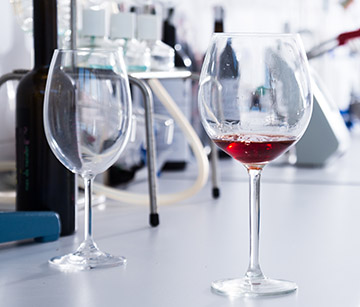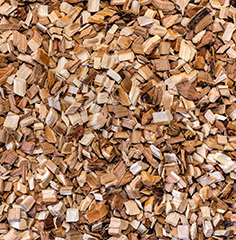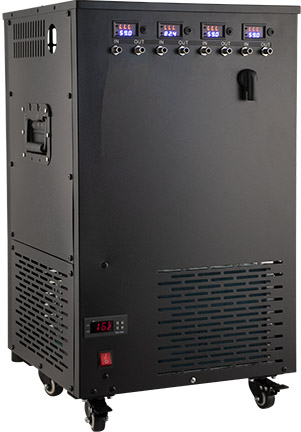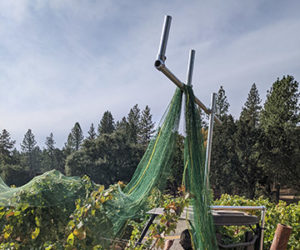
Readers of my books and columns who are making wine at home are sometimes frustrated that technologies I discuss such as flash détente, electrodialysis, and micro-oxygenation are not available to small-scale winemaking, and perhaps never will be. Yet there are many recent advances that are a boon to the micro-practitioner. Some are exclusively suited to small production and do not scale up for the large commercial industry.
We now have the capability to enhance extraction, automate fermentations, nearly eliminate water use, and cold stabilize without refrigeration. New fining agents include highly efficient vegan proteins, red-friendly bentonite, and microbial-controlling chitosans. Single-use plastics have replaced the much-despised variable-capacity tanks and breakdown cooperage. A vast array of new yeast products are now available to protect cold soaks and pre-crushed grape shipments, reduce acidity, enhance aromatics, and lower pH. Surprisingly affordable electronic devices are available to measure dissolved oxygen and to enable real-time monitoring of Brettanomyces and Acetobacter in barrels. Enzymatic advances have rendered obsolete the tedious and expensive winery labs of the past.
So this article is geared for you — the home winemaker and operators of small-scale wineries and will dig into these newer innovations. Talking about these advancements is impossible without dropping the names of products. While this article might be construed as a giant infomercial, to be clear neither WineMaker magazine nor the author endorse or profit from the sale of any of these innovations.
Bitartrate Crystal Magic
Few home winemakers have jacketed tanks and refrigeration systems capable of cold stabilization of white wines and rosés. Even if you are an exception, chill-proofing is not good for wine. Besides increasing the solubility of oxygen, thus promoting oxidation, bitartrate precipitation robs the wine of potassium, an important contributor to perceived body and flavor persistence. Commercial wineries, particularly those making jug wines principally sold in grocery stores, are obliged to cold-stabilize lest the inexperienced consumer think he has served his mother-in-law ground glass. Believe it or not, cold stabilization is the single most energy-consuming process in wine production, typically twice the kWh consumed during fermentation season.

Many alternatives have entered the market including mannoproteins, carboxymethyl cellulose, and gum arabic. These have one thing in common: They don’t work real well. Generally, they offer protection that lasts only a few months.
More recently, Enartis USA has introduced a patented proprietary potassium poly-aspartame that really works. It acts to disrupt the formation of so-called “wine diamonds.” The proprietary name for whites and rosés is Zenith Ono. The only prerequisite is that the wine must be adequately bentonited for heat stability. Since reds are always heat-stable, this is not a concern there, but Zenith Color does contain gum arabic as a color stabilizer.
I love this stuff. Simply dose the wine at bottling and don’t worry about the cold stabilization step.
Fine and Good
Besides its heat stabilization properties, bentonite has always been one of the home winemaker’s most useful tools for clarification of whites and rosés. Unfortunately, it’s murder on red wine color. Now at last, Vason has brought us Mastervin Compact, the world’s first color-friendly bentonite. I have also used it successfully on smoke-tainted Cabernet when it turned out that the taint was entirely in the suspended solids.
The making of high-terpene wines (Muscato, Riesling, Gewürztraminer, Vignoles) has always been plagued by bitterness and oxidative browning. It’s easy to understand why. These are the tastiest eating grapes and are the choicest items on the menu of bees and birds. To cauterize the wounds these pests inflict, these varieties have evolved highly tannic skins that seal off cuts and punctures in their tissues, just as occurs in bananas and apples. Unfortunately, when these tannins show up in wines, they can oxidatively polymerize, leading to browning. A side reactant of the browning reaction is the production of hydrogen peroxide, which attacks the wine’s aromatics, robbing freshness and leading to dull, stale, and petroleum characters.
In Germany’s Mosel region and in the Finger Lakes region of New York, the practice of hyper-oxidation of juice proactively removes these phenolics at the juice stage prior to fermentation.1 Once the brown polymers are formed, however, they need to be removed using a protein fining agent with a strong attraction for polyphenols but not prone to stripping flavor. The traditional animal-based agents (gelatin, egg albumin, isinglass, and casein) aren’t very good at this.
The good news is that highly suitable vegetable-based protein agents have emerged from a great deal of research in recent years. Prompted by consumers’ ethical concerns, the properties of a broad spectrum of sources have undergone screening, and several suppliers now offer an array of vegan products, principally from pea and potato. Vegan agents are superior simply because such studies have never been performed on animal agents.
Another new family of fining agents are the chitosans. Chitin is the structural material that comprise the shells of crustaceans and the structure of mushrooms. The black mold Aspergillus niger is used to produce chitosans that act physically to disrupt the cell membranes of microbes, available from many suppliers, and can be used to control the populations of runaway spoilage from Acetobacter and Brettanomyces species much more effectively than sulfur dioxide.
Analytical Toys
Speaking of spoilage organisms, a French company named Onafis has just released a suite of affordable instruments for your cellar. The B-Atmos bung ($300) measures cellar humidity, barometric pressure, and temperature inside and outside the barrel and can be set up to act as a thermostat that talks via bluetooth to your iPhone or HVAC system to regulate heating and cooling. Or for $900, the B-Evolution combines these functions with an ability to sense dissolved oxygen and detect Brettanomyces or Acetobacter activity in the barrel and provide an early warning.
Assessing oxygen pickup during storage, racking, and bottling is one of the most important quality control winemaking necessities. A decent dissolved oxygen meter used to be completely out of reach for the home winemaker. Oxidation prevention was left to guesswork and gut instinct.
The Milwaukee MW600 is a portable handheld instrument that now does the job for just over $200. Besides assessing oxygen pickup in wines, it can also assess headspace oxygen, taking the guesswork out of inert gassing of containers, minimizing waste, and assessing whether your technique is effective. If you are interested in the practice of juice pre-browning for your high-terpene whites, the MW600 can tell you exactly when you have completed the hyper-oxidation reaction to optimize tannin removal while preventing aroma loss.
What you want in your Christmas stocking is a tool that can replace that battery of analytical lab equipment some of you have invested in and eliminate the delays and breathtaking expense others incur sending samples off to professional labs. The new start-up Sentia now offers a unit that provides highly accurate, inexpensive, and immediate results for titratable acidity, free SO2, glucose, fructose, malic acid, and acetic acid. It works like a blood glucose monitor, with a drop of wine applied to a specialized strip inserted into the meter, producing readings in a few minutes at a cost of less than $5 per analysis. The unit employs dependable solid-state electrochemistry that requires no calibration.
The importance of immediate, on-site analysis cannot be overstated. Sending out your free SO2 samples will always return bad numbers due to the deterioration of samples during shipping. The same can be said for metabolic changes that may occur when wine glucose/fructose or malic acid samples are in transit. For titratable acidities at the juice stage, you need that number right now so you can make informed decisions about additions and treatments to raise or lower acid levels prior to fermentation.
While you may grit your teeth at its one-time cost of $2,300, if you are serious enough about making wine and honest about the true cost of alternatives, you’ll likely find it pencils out pretty well.

(L) The Sentia Wine Analyzer provides immediate results for testing TA, free SO2, glucose, fructose, malic acid, and acetic acid.
(C) The MW600 dissolved oxygen meter assesses oxygen pickup in your wine, as well as headspace oxygen and even when hyper-oxidation is done.
(R) Fermentations in GOlite plastic bags eliminate issues with air/bugs and are easy to monitor.
Single-Use Plastics
Many of you are aware of the innovations of Vijay Singh, a plastics engineer who revolutionized the global pharmaceutical fermentations industry and built a small winery in western New Jersey in which he turned his inventive genius to rethinking winery design. His GOfermentor (3⁄4-ton) and GOfermentorJR (100-lb./45-kg) auto-fermenters are becoming popular among home winemakers for their ability to mix fermentations all day and all night.
Vijay’s SmartLiners are an alternative to variable-capacity tank lids and breakdown cooperage, replacing them with a collapsible bio-liner.
The latest innovation is the GOliteTM system (pictured above). Fermentations of whites and rosés, which don’t require mixing, can now be fermented in these simpler systems for a small fraction of the cost.
Vijay is also working on a parade of micro-winery innovations including an affordable sterile bottling system for sweet wines. Stay tuned.
Exotic Woods

By now, most readers will be familiar with the vast array of oak chips, powders, balls, staves, cubes, spirals, and inserts on the market from every conceivable forest source and a wide array of toast levels. An entire issue of Consumer Reports could only scratch the surface of the variability in characteristics and quality, and I certainly won’t attempt it here. You probably already have your favorites.
What’s new is the emergence of non-oak exotic woods. These are being championed by a Chilean cooperage, Toneleria Nacional, which provides both barrels and chips from several trees. Here I will highlight a couple of my favorites. Cherrywood chips are wonderful for enhancing the red fruit aromas of various reds such as Pinot Noir, Grenache, and Sangiovese in levels of 1–2 g/L. I like chips more than barrels because you can do two-week soak trials to determine the right level to use.
This goes double for acacia chips. These are exclusively used in whites and rosés to impart a honeysuckle aromatic enhancement as well as a lushness to the palate. They can be overwhelming even at low rates, so trials are essential. I will commonly end up using 0.15–0.2 g/L, though trials are critical as sometimes the wood’s impact is not desired.
The Yeast You Can Do
A staggering number of novel yeast strains, both V. Saccharomyces and non-Saccharomyces, have become commercially available in recent years. Far beyond the traditional role of converting sugar into alcohol, you can now choose selections to lower malic acid, aid phenolic extraction, lower pH, enhance ester or thiol production, and a host of other winemaking miracles. Bob Peak covered many of these strains in a recent “Techniques” column, online at: www.winemakermag.com/technique/special-purpose-wine-yeasts-2.
Here I will mention only one: The bio-protective strain of Metschnikowia pulcherrima developed by Lamothe-Abiet, the materials arm of Bucher-Vaslin, under the proprietary name Excellence B-Nature. This yeast produces bio-regulators that suppress the growth of spoilage bacteria and yeasts such as Acetobacter, Gluconobacter, Pediococcus, Brettanomyces, Kloeckera, and Candida. It can be used to protect grapes or must during trans-country shipping or cold soaks, and can also be sprayed on rotting fruit a few days before harvest to prevent development of volatile acidity. Amazing as it may seem, it becomes the dominant organism until the only organism immune to its inhibition comes along — you guessed it — good old Saccharomyces. Because it can’t tolerate alcohol, it checks out as soon as fermentation commences, leaving wine yeast to do its job on a nice clean must.
Saving the Best for Last

Dr. Richard Smart, perhaps the world’s leading viticulturist, conceived in 2014 a brilliant theory that has revolutionized winemaking. In 2019, I was privileged to hear Dr. Smart speak at a workshop in California where he introduced that concept of Accentuated Cut Edges (ACE). He explained that the wax cuticle on the outside surface of grapes prevents extraction, which instead must diffuse through the inner pectin layer over the course of several days. The exception is that rapid extraction of color and flavor occurs from skin cells located along the cut edge created by crushing.
But this is only a tiny fraction of skin cells. His idea was to use a rotating blade to cut the skin into 8–10 pieces, thus facilitating rapid extraction. In 2014, he persuaded Dr. Angela Sparrow, an enologist at the University of Tasmania, to try this out on Pinot Noir. The results were astonishing.
Dr. Smart licensed his idea to the Della Tofolla Group, who produced the Della Toffola Maceration Accelerator (DTMA) for commercial wineries. You can’t afford it. Neither could I, with my two-ton (1,800-kg) lots. But Dr. Sparrow’s original experiments employed an immersion blender from Robot Coupe with a variable speed that allowed her to dial in the right RPMs to cut the skin while pushing the seeds, which are heavier, away from the blade. So I bought one of those for under $1,000.2
Now, I had over fifty vintages under my belt and thought I had my game down pretty good. Little did I suspect that my wines would take a quantum leap in quality: Deeper color, rounder tannins, richer fruit aromatics, and improved density on the palate. It works best in lighter varieties, so I wouldn’t use it on Petite Sirah, but even Cabernet Sauvignon is greatly improved. Who knew?
That’s my list. If you need any help implementing any of these, just email me at [email protected]. I’m at your service.
References:
1 www.ajevonline.org/content/49/1/65





